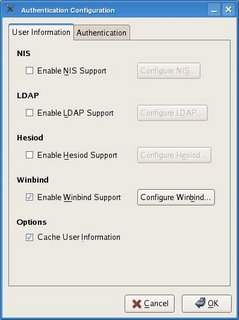Admin Blog Has Moved
I found that wordpress's blog is easier to maintain. I have exported my Admin Blog to here.
Admin Blog Has Moved
MSH is now Microsoft PowerShell
Set-ExecutionPolicy RemoteSigned
Windows Hidden File Attribute
H:\>attrib -h enterprise
Not resetting system file - H:\enterprise
H:\>attrib -a enterprise
Not resetting hidden file - H:\enterprise
H:\>attrib -a -h enterprise
Not resetting system file - H:\enterprise
H:\>attrib /s /d -s -h enterprise
Run Applications Written for Other Languages (Windows XP)



Fedora Core 5 Installation Notes
dvd+rw-format -f /dev/cdrom
rpm --import /media/disk/RPM-GPG-KEY*
yum localinstall /media/disk/Fedora/RPMS/kde*
rpm -ihv http://rpm.livna.org/fedora/5/x86_64/livna-release-5-4.noarch.rpm
rpm -ihv http://ayo.freshrpms.net/fedora/linux/5/x86_64/RPMS.freshrpms/freshrpms-release-1.1-1.fc.noarch.rpm
yum -y install xine xine-lib xine-skins
[base-i386]
name=base-i386
baseurl=http://download.fedora.redhat.com/pub/fedora/linux/core/$releasever/i386/os/
gpgcheck=1
enabled=0
rpm -e firefox
yum --enablerepo=base-i386 install firefox.i386
yum -y install flash-plugin
yum -y --disablerepo=livna install mplayer mplayer-skins mplayer-fonts
rpm -e mozilla yelp
name=Livna for Fedora Core $releasever - i386 - Base
baseurl=
http://rpm.livna.org/fedora/$releasever/i386/
http://livna.cat.pdx.edu/fedora/$releasever/i386/
http://wftp.tu-chemnitz.de/pub/linux/livna/fedora/$releasever/i386/
http://ftp-stud.fht-esslingen.de/pub/Mirrors/rpm.livna.org/fedora/$releasever/i386/
failovermethod=priority
#mirrorlist=http://rpm.livna.org/mirrorlist-5
enabled=0
gpgcheck=1
gpgkey=file:///etc/pki/rpm-gpg/RPM-GPG-KEY-livna
yum -y --eanablerepo=livna-i386,base-i386 mplayerplug-in.i386
yum -y install ndiswrapper
ndiswrapper -i netbc564.inf
alias wlan0 ndiswrapper
depmod -a
modprobe ndiswrapper
ctrl_interface=/var/run/wpa_supplicant
ctrl_interface_group=wheel
network={
ssid="SSIDNAME"
key_mgmt=WPA-PSK
psk="your_password"
}
INTERFACES="-iwlan0"
DRIVERS="-Dndiswrapper"
service wpa_supplicant start
wpa_supplicant -i wlan0 -D ndiswrapper -c /etc/wpa_supplicant/wpa_supplicant -dd

#%PAM-1.0
auth required pam_env.so
auth include system-auth
account required pam_nologin.so
account include system-auth
password include system-auth
session include system-auth
session required pam_loginuid.so
session optional pam_console.so
session required pam_mkhomedir.so skel=/etc/skel umask=0022
#%PAM-1.0
auth required pam_securetty.so
auth include system-auth
account required pam_nologin.so
account include system-auth
password include system-auth
# pam_selinux.so close should be the first session rule
session required pam_selinux.so close
session include system-auth
session required pam_loginuid.so
session optional pam_console.so
session required pam_mkhomedir.so umask=0022
# pam_selinux.so open should be the last session rule
session required pam_selinux.so open
ssh DOMAIN-NAME\\username@host.domain-name.com
yum -y install rdesktop
yum -y install vnc
rdesktop -g 1024x768 -a 16 server.domain-name.com
vncviewer server2.domain-name.com
Setup RAID on Dimension 8400
WQL and Path
Set colFiles = objWMIService.ExecQuery ("SELECT * FROM CIM_DataFile" & _
" WHERE Drive = 'c:' AND Extension = 'mdb' And Path = '\windows\' ")
Set colFiles = objWMIService.ExecQuery ("SELECT * FROM CIM_DataFile" & _
" WHERE Drive = 'c:' AND Extension = 'mdb' And Path = '\\windows\\' ")
Create a Hyperlink in Excel Spreadsheet Using VBScript
Dim objExcel
Set objExcel = WScript.CreateObject("Excel.Application")
objExcel.Visible = TRUE
objExcel.Workbooks.Open "C:\bin\test.xls"
objExcel.Workbooks(1).Activate
objExcel.Workbooks(1).Worksheets(1).Range("A1").Select
Dim sLinkAddress
sLinkAddress = "http://www.google.com"
objExcel.Workbooks(1).Worksheets(1).Hyperlinks.Add _
objExcel.Selection, sLinkAddress
objExcel.Workbooks(1).SaveAs "C:\bin\test.xls"
objExcel.Quit
set objExcel = nothing
Popular Web 2.0 Colors
XviD Files Crash Windows Explorer
Event Type: Information
Event Source: Winlogon
Event Category: None
Event ID: 1002
Date: 2/2/2006
Time: 12:27:02 PM
User: N/A
Computer: MyComputer
Description:
The shell stopped unexpectedly and Explorer.exe was restarted.
For more information, see Help and Support Center at
http://go.microsoft.com/fwlink/events.asp.
Intel iMac and Samsung ML-2551N
Silent Install for Firefox and Thunderbird
VB Script wrapper function for regular expression.
Function Found(strTarget, strPattern)
Dim regEx
Set regEx = New RegExp
regEx.Pattern = strPattern
regEx.IgnoreCase = False
Found = regEx.Test(strTarget)
set regEx = Nothing
End Function
WMI script to find files last accessed on a certain date.
dtDate = "5/2/2005"
strSearchFolder = "C:\Windows"
Set objFSO = CreateObject("Scripting.FileSystemObject")
WScript.Echo "File(s) last accessed on: " & dtDate & " in: " & strSearchFolder
EnumAndCheckFiles objFSO.GetFolder(strSearchFolder), dtDate
Sub EnumAndCheckFiles(objFolder, dtDate)
Set objFiles = objFolder.Files
For Each objFile in objFiles
CheckFile objFile, dtDate
Next
For Each objSubfolder in objFolder.SubFolders
EnumAndCheckFiles objSubfolder, dtDate
Next
End Sub
Sub CheckFile(objFile, dtDate)
If DateDiff("d", objFile.DateLastAccessed, dtDate) = 0 Then
WScript.Echo objFile.Path
End if
End Sub
Mac OS 10.4 Tiger Stealth Mode
Free Windows Rootkits Detection Tools
WMI and Day Light saving time
Batch file to list all the methods in WMI command line tool (wmic).
@ECHO OFF
FOR /F %%a IN ('wmic alias list instance ^| FIND /v "Friend" ') DO (
FOR /F %%b IN ('wmic %%a /? ^| FIND /i "%%a CALL"' ) DO (
ECHO wmic %%b CALL /?
wmic %%b CALL /?
)
)
Disable Windows XP SP2 Firewall
Windows Registry Editor Version 5.00
[HKEY_LOCAL_MACHINE\SOFTWARE\Policies\Microsoft\WindowsFirewall]
[HKEY_LOCAL_MACHINE\SOFTWARE\Policies\Microsoft\WindowsFirewall\DomainProfile]
"EnableFirewall"=dword:00000000
[HKEY_LOCAL_MACHINE\SOFTWARE\Policies\Microsoft\WindowsFirewall\StandardProfile]
"EnableFirewall"=dword:00000000
To set FireFox as your default browser for Mac OS 10.3,